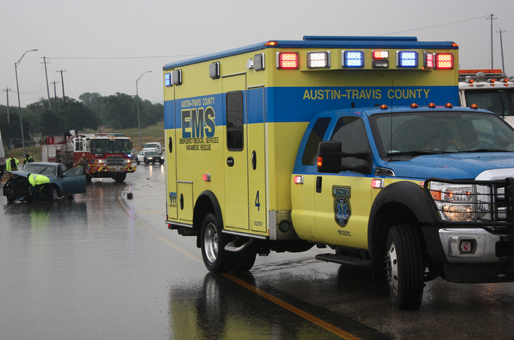New EMS chief outlines progress on collections
Friday, April 29, 2022 by
Jo Clifton With a projected budget deficit by Fiscal Year 2027, any news about increasing collections from those who owe the city of Austin money, including the state of Texas, is good news for City Council. Robert Luckritz, who recently joined the city as chief of Austin-Travis County Emergency Medical Services, brought some of that good news to the Council Audit & Finance Committee on Wednesday.
Mayor Pro Tem Alison Alter, who chairs the committee, noted that she introduced a budget rider last year to assist EMS in improving its collections, as called for by an equity and efficiency study done for the city last year.
Luckritz explained that EMS had a backlog of 77,000 claims before hiring a vendor to help code the claims. Initially, the city asked the vendor to work on a batch of 11,000 claims. That worked out well and the city has now asked the vendor to address the entire backlog.
Although Luckritz expects the vendor to clear the backlog by October, unpaid claims continue to mount. He said the department currently has enough funds to pay the vendor through the end of this fiscal year and he expects to ask Council for additional funding to continue that program in FY 2022-’23.
An alternative would be to add more staff to the EMS billing department, which is currently understaffed, he said.
Completeness and accuracy of documenting services is a problem for Austin-Travis County EMS, but it’s also a problem nationwide, according to Luckritz. He said supervisors are out in the field working with frontline staff so they understand the importance of accurate documentation. In addition, he said the department is working with a firm that does data analytics.
Page, Wolfberg & Wirth was hired last year to review payment data to ensure accurate reporting and identify opportunities to maximize revenues. Some problems relate to errors made while inputting data, but other problems are more technical. The company will be able to monitor information put into the system in real time to help determine any changes that might be needed. Luckritz said he is expecting a report from the company at the end of May.
Looking at documentation of services was one of the recommendations from the equity and efficiency study. The study also recommended that the city revise its charity care policy. In the past, the city only made claims for reimbursement from the state for people who were described as homeless, or if the patient died, “having no estate.” The charity care policy has now been updated with 10 additional eligibility categories, Luckritz said, noting that the claims for FY 2020-’21 were seven times greater than the claims submitted the year before.
In 2019-2020, Austin-Travis County EMS submitted about $1.7 million in charity care claims to the state and got about 66 percent payment on the claims submitted. “This most recent year, we submitted $15 million in claims,” Luckritz said, noting that it’s challenging to estimate how much the state will pay on those claims. “Conservatively, we are anticipating about $5 million … but it could be significantly higher than that,” depending on what claims come in from the rest of the state.
EMS raised the rate for ambulance service before Luckritz came to Austin. He noted that the cost of service jumped from $1,139 to $1783.63. The cost of other services is currently being evaluated, and should be done by mid-summer.
“This is an extremely important effort on the part of the city,” Alter said. “You take a look at the graph in our financial forecast and we are forecasting deficits three-four years out that just get progressively bigger. This is a rare opportunity for us to improve our revenue in a way that we can accommodate those that are unable to pay,” she said, concluding that she wants Luckritz and Chief Financial Officer Ed van Eenoo to keep on top of these opportunities to address the projected shortfall.
“We can’t necessarily count those revenues in this budget, but it is an extremely promising,” she said.
The Austin Monitor’s work is made possible by donations from the community. Though our reporting covers donors from time to time, we are careful to keep business and editorial efforts separate while maintaining transparency. A complete list of donors is available here, and our code of ethics is explained here.
You're a community leader
And we’re honored you look to us for serious, in-depth news. You know a strong community needs local and dedicated watchdog reporting. We’re here for you and that won’t change. Now will you take the powerful next step and support our nonprofit news organization?



